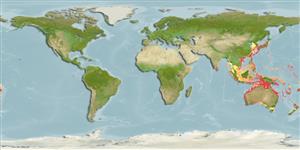Common names from other countries
>
Ovalentaria/misc (Various families in series Ovalentaria) >
Pomacentridae (Damselfishes) > Chrominae
Etymology: Chromis: Greek, chromis = a fish, perhaps a perch (Ref. 45335).
More on author: Tanaka.
Environment: milieu / climate zone / depth range / distribution range
Ökologie
seewasser riff-verbunden; standorttreu; tiefenbereich 3 - 30 m (Ref. 125611). Tropical
Western Pacific: restricted to Japan and Taiwan, with vagrants ranging southward to Malaysia.
Size / Gewicht / Alter
Maturity: Lm ? range ? - ? cm
Max length : 9.5 cm SL Männchen/unbestimmt; (Ref. 125611)
Rückenflossenstacheln (insgesamt) : 13 - 14; Rückenflossenweichstrahlen (insgesamt) : 11 - 12; Afterflossenstacheln: 2; Afterflossenweichstrahlen: 9 - 10. This species is distinguished by the following set of characters: D XIII-XIV,11-12 (usually 12); A II,9-10 (usually 10); pectoral-fin rays 18-20 (usually 19); pelvic-fin rays I,5; caudal-fin rays principal 15, branched 13; procurrent spiniform caudal-fin rays 2; tubed lateral-line scales 16-19 (usually 18-19); gill rakers 7-11 + 18-23, total rakers 26-33 (usually 26-29) (Ref. 125611).
Adults inhabit lagoon and seaward coral and rocky reefs (Ref. 9710). Prefer habitat consisting of boulder substrates or mixed rock, rubble, and sand, at depths between about 3 and 30 m (Ref. 125611). Oviparous, distinct pairing during breeding; eggs demersal and adhere to the substrate, and males guard and aerate the eggs (Ref. 205). Diurnal species (Ref. 54980; 113699).
Life cycle and mating behavior
Maturities | Fortpflanzung | Spawnings | Egg(s) | Fecundities | Larven
Oviparous, distinct pairing during breeding (Ref. 205). Eggs are demersal and adhere to the substrate (Ref. 205). Males guard and aerate the eggs (Ref. 205).
Allen, G.R. and M.G. Allen, 2021. Two new species of Chromis (Teleostei: Pomacentridae) from northwestern Australia and the southwestern Pacific Ocean, previously part of C. fumea (Tanaka, 1917). J. Ocean Sci.Foundation 38:78-103. (Ref. 125611)
IUCN Rote Liste Status (Ref. 130435)
CITES (Ref. 128078)
Not Evaluated
Bedrohung für Menschen
Harmless
Nutzung durch Menschen
Tools
Zusatzinformationen
Download XML
Internet Quellen
Estimates based on models
Preferred temperature (Ref.
115969): 18.8 - 28.8, mean 27.2 (based on 636 cells).
Phylogenetic diversity index (Ref.
82804): PD
50 = 0.5000 [Uniqueness, from 0.5 = low to 2.0 = high].
Bayesian length-weight: a=0.01259 (0.00579 - 0.02736), b=3.03 (2.84 - 3.22), in cm Total Length, based on LWR estimates for this (Sub)family-body shape (Ref.
93245).
Trophic level (Ref.
69278): 3.4 ±0.45 se; based on food items.
Widerstandsfähigkeit (Ref.
120179): hoch, Verdopplung der Population dauert weniger als 15 Monate. (Preliminary K or Fecundity.).
Fishing Vulnerability (Ref.
59153): Low vulnerability (10 of 100).
